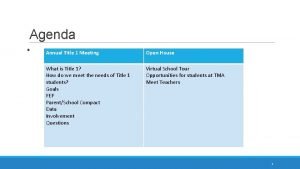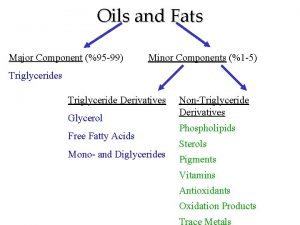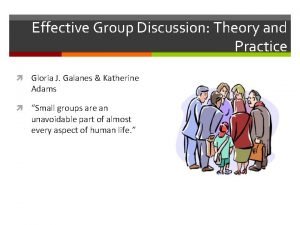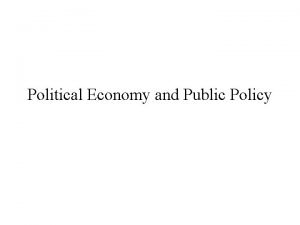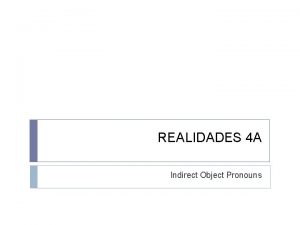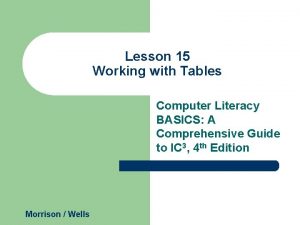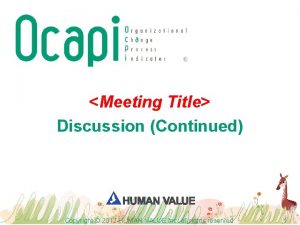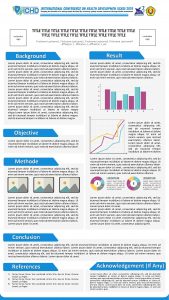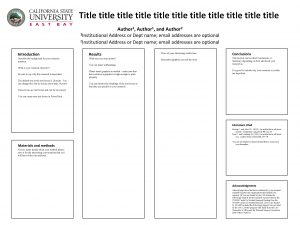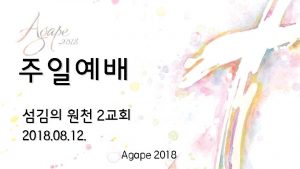Meeting Title Discussion Continued Copyright 2018 HUMAN VALUE







![5. Renew the desirable state of the group p [Individually] Consider what the desirable 5. Renew the desirable state of the group p [Individually] Consider what the desirable](https://slidetodoc.com/presentation_image/405c3a851d80ae7e87bb2b3c181f4725/image-8.jpg)


















- Slides: 26

<Meeting Title> Discussion (Continued) Copyright © 2018 HUMAN VALUE Inc. all rights reserved. 1

Discussion Procedure (Tentative) 1. Reflect on the progress individually 2. Reflect on the progress with the group 3. Read the report individually 4. Discuss the report 5. Renew the desirable state of the group 6. Determine actions to be taken *For discussions with a large number of people, it is suggested to first discuss in small groups of four or five, then to share the discoveries with the whole group afterward. Copyright © 2018 HUMAN VALUE Inc. all rights reserved. 2

Etiquettes for Discussions p Participants should be treated as equals and free from roles and positions. p Participants should not stick to their own opinion. p Participants should be open about their thoughts and background. p Participants should try to understand the background behind others’ opinions. p Participants should not deny or judge others’ opinions. p Participants should not force through their conclusions on others. Copyright © 2018 HUMAN VALUE Inc. all rights reserved. 3

1. Reflect on the progress individually p Look back on what happened after the previous discussion. Think about how your actions or feelings changed, and what small changes you have seen in your group. Write them down on sticky notes. n Focus on small improvements that can be seen as a result. There is no need to check whether the action plan has been implemented properly as planned. p Time: n ** Minutes (about 5 minutes) Copyright © 2018 HUMAN VALUE Inc. All Rights Reserved. 4

2. Reflect on the progress with the group p Read aloud and share your notes with the whole group. If you notice any similar notes, stick your notes close to it. p After everybody finished sharing the sticky notes, discuss comments and thoughts on: n The actions you decided on as a group/personally. n Changes actually seen in the group. n …etc p Time: n ** Minutes (about 10 -20 minutes) for sharing sticky notes n ** Minutes (about 15 -20 minutes) for discussion Copyright © 2018 HUMAN VALUE Inc. All Rights Reserved. 5

3. Read the Report Individually p Before starting the discussion, let’s take a moment to read the report individually. Write down “your first impression” or “particular parts in the report that attracted your attention” on sticky notes. n It may also be useful to check the previous report and compare the results. p Time: n ** Minutes (about 5 -10 minutes) Copyright © 2018 HUMAN VALUE Inc. all rights reserved. 6

4. Discuss the Report p First, present the sticky notes and share your views with the group. p Let’s identify the points and tendency of the results worth noting. p We will discuss further to explore “what is happening” and “possible reasons behind the results. ” p Time: n ** Minutes (about 30 -60 minutes) Copyright © 2018 HUMAN VALUE Inc. all rights reserved. 7
![5 Renew the desirable state of the group p Individually Consider what the desirable 5. Renew the desirable state of the group p [Individually] Consider what the desirable](https://slidetodoc.com/presentation_image/405c3a851d80ae7e87bb2b3c181f4725/image-8.jpg)
5. Renew the desirable state of the group p [Individually] Consider what the desirable state of the group would look like for you. Write them down on sticky notes. The following questions may help you clarify your thoughts. n What kind of conversation will be heard in your group? n What will the group meetings look like? n What is the desirable state for the “Quality of Relationships, ” “Quality of Collective Thinking, ” “Quality of Actions, ” and “Quality of Results? ” n …etc p [With the Group] Present your sticky notes. After everybody finished, share comments and thoughts. p Time: n ** Minutes (about 5 minutes) for writing down individually n ** Minutes (about 15 -25 minutes) for sharing with the group Copyright © 2018 HUMAN VALUE Inc. All Rights Reserved. 8

6. Determine Actions to be Taken p We will identify the leverage point to move the organization forward. p Let’s discuss and find ways to improve the organization together. n Decide on one or two actions that are achievable and easy to try. p Next, write down an action you personally would like to try on sticky notes and we will close the discussion by introducing them to the group. p Time: n ** Minutes (about 20 -30 minutes) Copyright © 2018 HUMAN VALUE Inc. all rights reserved. 9

REFERENCES: CONTINUOUS EFFORTS FOR CHANGE Copyright © 2018 HUMAN VALUE Inc. all rights reserved. 10

Keys to Continuous Efforts p p Nurture small changes instead of managing them n Try not to over-manage the situation by asking why it does not work or how to make it work, even when the action plan does not seem to achieve an outcome. Members easily lose the energy to continue the efforts once it is perceived as actions imposed by someone n You may come across important findings and discoveries while working on the action plan and eventually come up with another plan. n It is important to focus on what changes can be seen as a result. n It is crucial to focus on these improvements and their influences, and for everybody to think together about how they can be nurtured. Continue open conversations n We cannot expect people's mindset and behavior or an organization's culture to completely change in a short term like a few days or a month. n It is important to hold ongoing discussions to celebrate small changes and to continuously find next steps toward the desirable state. By doing so, the cumulative effects of these small improvements can lead to profound change n Even after holding a discussion with the report, share your thoughts, findings, and changes to each other more often on a daily basis – it will create a positive energy in the group. Copyright © 2018 HUMAN VALUE Inc. All Rights Reserved. 11

REFERENCES: WHAT IS OCAPI Copyright © 2018 HUMAN VALUE Inc. all rights reserved. 12

Ocapi Supports Your Change Efforts — Without a Compass, it is Difficult to Stay on Course p The Reality of Organizational Change We can not expect people’s mindset and behavior or an organization’s culture to completely change in the short term – like a few days or a month. n However, looking back, most profound changes are the result of cumulative effects of continuous small improvements. n p Not to Give Up Mid-way n When group members try making improvements, and are not able to see big changes or immediate results, they are likely to become discouraged and garner the disappointment of those around them. As a result – despite a good start – people are likely to give up mid-way. Copyright © 2018 HUMAN VALUE Inc. all rights reserved. 13

Ocapi Supports Your Change Efforts (Cont’d) — Without a Compass, it is Difficult to Stay on Course p Assessments Generate Confidence and Support n It may take from one to three years for big improvements to be noticeable. Without measurable results during this period, and without support from management and their colleagues, group members may lose their energy to continue efforts to bring about organizational change. Feedback is important to generate processes for implementing organizational change involving everybody, and to create value through trial and error. p A Compass is Essential n An indicator is critical for finding and expanding small changes and for obtaining objective information to start discussions on what steps can be taken. Copyright © 2018 HUMAN VALUE Inc. all rights reserved. 14

What is Ocapi is an assessment tool that helps organizations and communities identify their conditions from three aspects – quality of relationships, quality of collective thinking, and quality of actions – and generate continuous efforts for positive change. Copyright © 2018 HUMAN VALUE Inc. all rights reserved. 15

The Core Theory of Success p The Core Theory of Success was developed by Daniel H. Kim. p In Ocapi, five levels of properties are identified in each quality of the Core Theory of Success (quality of relationships, quality of collective thinking, and quality of actions), which show the progress of change efforts. Copyright © 2018 HUMAN VALUE Inc. all rights reserved. 16

Quality of Relationships Properties Level 1 2 3 4 5 Property Description Greetings Degree to which people sincerely greet each other Courtesy Degree to which everybody has pleasant conversation with others Comfortable atmosphere Degree to which people don't hesitate to talk to others Communication Amount of conversations in the workplace Thanks Degree to which people naturally express appreciation to others Activity Degree to which workplace is pleasant and lively Diversity Degree to which people treat others with respect, regardless of position or experience Awareness Degree to which people are aware of each other's workload, progress, problems, or worries Openness Degree to which people are open to sharing their thoughts and feelings Boundaryless Degree to which people meet and communicate with others who are in different roles and divisions Connectedness Degree to which people share personal visions and their aspirations toward their profession Joint action Degree to which cooperation transcends job role and position Trust Degree of mutual trust and mutual acceptance Expansion Degree to which people expand their areas of activities and interact with people outside the organization to talk about their visions Copyright © 2018 HUMAN VALUE Inc. all rights reserved. 17

Quality of Collective Thinking Properties Level 1 2 3 Property Broad View Degree to which people are interested in the intentions of others’ comments and the background of what is happening Thinking together Degree to which people discuss and consider ideas with others Acceptance Degree to which people accept the situation and are prepared to try difficult or unproven paths Positive thinking Degree to which people focus on the positive aspects and opportunities of the situation Initiative Degree of willingness to take action, focusing on possibilities Envisioning Degree to which people acknowledge each other's future hopes and visions on a daily basis Involvement Degree to which people feel personally invested in organization’s circumstances Systems thinking Degree to which people are flexible and comfortable with complexity Self-reflection Degree to which people review and improve their behavior, reasoning, and motives Creativity Degree to which people develop innovative methods and ideas Ongoing quest Degree to which people continuously explore their purpose Confidence Degree to which people believe that present circumstances have positive influences on the future and the future will take a turn for the better Reciprocity Degree to which people believe that their personal development and the organization's development are interlinked Viewpoint Degree to which people consider all the angles and take a broad, long-term view of their influence on the world Purposeful existence Degree to which people create a more desirable vision for people and society, and continue to evolve the purpose of the organization through work 4 5 Description Copyright © 2018 HUMAN VALUE Inc. all rights reserved. 18

Quality of Actions Properties Level 1 2 3 4 Property Description Smiles Degree to which natural smiles are seen Friendly Degree to which the workplace environment is cheerful, open-minded, and comfortable Agility Degree to which people promptly share and discuss ideas, and quickly take actions Change Degree of people’s willingness to change their habits and way of thinking Support Degree to which everybody takes action to support others New customs Degree to which people challenge themselves to transcend existing frameworks and customs Ownership Degree to which everybody finds something they can do to contribute to a desirable future Wholeheartedness Degree to which everybody wholeheartedly works on the task at hand Volunteer teams Degree to which teams form naturally to engage in quality discussions and voluntarily take action for a desirable future Attention to detail Degree to which everybody understands the impact of small things and behaves thoughtfully Self-organization Degree to which successful initiatives by voluntary teams become an important part of organizational strategy Co-Creation Degree to which knowledge, experience, and ideas of the whole group are integrated to create completely new things 5 Copyright © 2018 HUMAN VALUE Inc. all rights reserved. 19

Interrelation of Properties in Different Qualities p Horizontal Influence of Improvements n The image of horizontal influence is on the next slide. It shows how the properties in different qualities are interrelated to each other. n You may see that each quality improves vertically, starting from level 1 up to level 5. At the same time the improvement of each quality has a positive impact on the other qualities. n For example, if level 2 in the quality of relationships improves, it is likely to influence both level 3 in the quality of relationships and level 1 in the quality of collective thinking. Copyright © 2018 HUMAN VALUE Inc. all rights reserved. 20

Interrelation of Properties in Different Qualities Quality of Relationships 1 2 Greetings Quality of Collective Thinking 1 Courtesy Comfortable atmosphere 2 Thanks Activity 3 Awareness Openness Connectedness Joint action 4 Trust Expansion Smiles Friendly Agility 2 Change Initiative Support Envisioning New customs 3 Ownership Systems thinking Wholeheartedness Self-reflection Volunteer teams Creativity Boundary-less 5 Positive thinking Involvement Diversity 4 Thinking together 1 Acceptance Communication 3 Broad View Quality of Actions 4 Ongoing quest Attention to detail Confidence Self-organization Reciprocity 5 Co-Creation Viewpoint 5 Purposeful existence Copyright © 2018 HUMAN VALUE Inc. all rights reserved. 21

REFERENCES: REPORT CONTENTS Copyright © 2018 HUMAN VALUE Inc. all rights reserved. 22

1. Acknowledge the Differences of Members’ Perceptions Quality of Results The quality of results indicates the group members’ perception regarding three aspects – creating people value, creating enterprise value, and creating shared value. The figures in the graph show the percentage of the group members that selected each choice. As the members have various expectations and viewpoints, perceptions of a situation will also differ. Quality of Results Average values of all responses for each question are shown here. Engagement Average values of all responses for each question are shown here. Evaluations on Progress of Workplace Improvement The group members’ perception on progress of improvements in the workplace is presented. The figures in the graph show the percentage of the group members that selected each choice. Engagement This sections shows how group members perceive three characteristics that measure engagement levels within a team. Priorities and perceptions differ depending on the person. Make sure to listen carefully to really catch what members are feeling. Copyright © 2018 HUMAN VALUE Inc. all rights reserved. 23

2. Identify the Levels and Properties That Have Higher Scores Average values for each level are shown here. A smiley icon will appear when the level averages are 4. 0 or higher. The numbers in the graphs are the average values of all responses for each property. Copyright © 2018 HUMAN VALUE Inc. all rights reserved. 24

3. Identify the Levels and Properties That Have Lower Scores When You See a Significant Gap Between Levels 1. Look at each layer in a horizontal direction – you may see a significant gap between layers. 3. In this example, the average values for the level 4 of quality of relationships and the level 3 of quality of collective thinking are smaller than the ones of the lower levels – this may be the gap in this example. Focusing on this gap in the discussion may provide a good hint for finding the next step forward. 2. In this example, you will see smiley icons on the third layers and the above, except the level 2 of the quality of collective thinking. The level 2 of quality of collective thinking still has a high score, which almost reaches 4. 0. It could be said that the change process has progressed up to this level. Copyright © 2018 HUMAN VALUE Inc. all rights reserved. 25

3. Identify the Levels and Properties That Have Lower Scores When You Do Not See a Significant Gap Between Levels Check to see if there is any level or property that attracts your attention. Copyright © 2018 HUMAN VALUE Inc. all rights reserved. 26
 Meeting title for discussion
Meeting title for discussion Penciptaan nilai adalah
Penciptaan nilai adalah Copyright © 2018
Copyright © 2018 Copyright © 2018 all rights reserved
Copyright © 2018 all rights reserved Fractional distillation introduction
Fractional distillation introduction Que letra continua m v t m j
Que letra continua m v t m j Aua meeting 2018
Aua meeting 2018 Nrg oncology meeting 2018
Nrg oncology meeting 2018 Nrg virtual meeting
Nrg virtual meeting Table in html
Table in html For today's meeting
For today's meeting Today meeting or today's meeting
Today meeting or today's meeting What is meeting and types of meeting
What is meeting and types of meeting Types of meeting
Types of meeting Title 1 meeting agenda
Title 1 meeting agenda Reports and proposals
Reports and proposals Title title
Title title Saponification value
Saponification value Semi drying oil definition
Semi drying oil definition Effective group discussion defines human communication as
Effective group discussion defines human communication as Human development index 2018
Human development index 2018 Romeo and juliet act 2 scene 2 script
Romeo and juliet act 2 scene 2 script Important things that happened in act 4 of romeo and juliet
Important things that happened in act 4 of romeo and juliet Indirect object pronouns (p. 199)
Indirect object pronouns (p. 199) Abbreviation of continued
Abbreviation of continued Example of signal word
Example of signal word Table continued
Table continued














